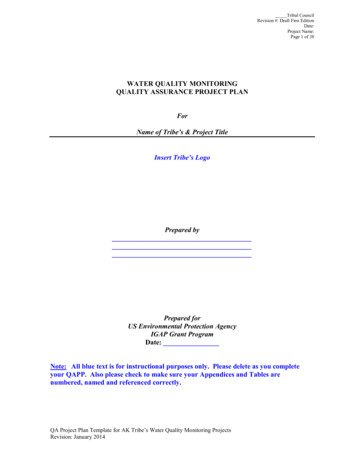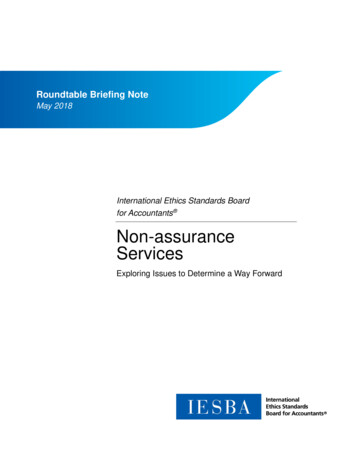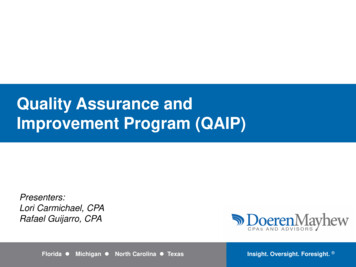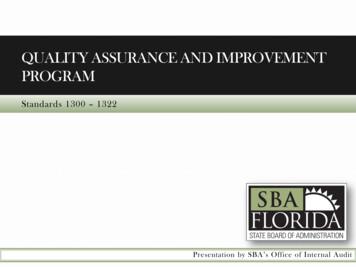
Transcription
Tribal CouncilRevision #: Draft First EditionDate:Project Name:Page 1 of 38WATER QUALITY MONITORINGQUALITY ASSURANCE PROJECT PLANForName of Tribe’s & Project TitleInsert Tribe’s LogoPrepared byPrepared forUS Environmental Protection AgencyIGAP Grant ProgramDate:Note: All blue text is for instructional purposes only. Please delete as you completeyour QAPP. Also please check to make sure your Appendices and Tables arenumbered, named and referenced correctly.QA Project Plan Template for AK Tribe’s Water Quality Monitoring ProjectsRevision: January 2014
Tribal CouncilRevision #: Draft First EditionDate:Project Name:Page 2 of 38ACKNOWLEDGEMENTSThis Quality Assurance Project Plan (QAPP) template and guide was revised andupdated by the University of Alaska Anchorage from the 2004 template and written by theNative American Fish and Wildlife Society, Cook Inlet Keeper, and University of AlaskaAnchorage’s Environment and Natural Resources Institute. This revision has been reviewedand approved by the United States Environmental Protection Agency (EPA), and AlaskaDepartment of Environmental Conservation (ADEC). Special thanks to Gina Grepo-Grove,the USEPA Region 10 QA Manager, for her thorough review, guidance, and assistance in thedevelopment of this template. Thanks to Douglas Kolwaite, Quality Assurance Officer withADEC Division of Water, for his thorough and timely review and input.Many thanks to all the Native Alaskans from villages across Alaska and the volunteersfrom the Cook Inlet Citizens’ Environmental Monitoring Program (CEMP) who haveattended the various trainings that help make this document possible.QA Project Plan Template for AK Tribe’s Water Quality Monitoring ProjectsRevision: January 2014
Tribal CouncilRevision #: Draft First EditionDate:Project Name:Page 3 of 38A. PROJECT MANAGEMENT AND ORGANIZATIONA1. APPROVAL PAGEName:Title:Tribal Council ElderOrganization:Signature:Date:Name:(Tribe’s Project Manager)Title:Project ManagerOrganization:Signature:Date:Name:(Tribe’s Quality Assurance Officer – if available)Title:QA ect:Organization:IGAP CoordinatorAlaska Tribal IGAP ProgramUSEPASignature:Date:Name:Gina Grepo-GroveTitle:Quality Assurance ManagerOrganization: U.S. EPA, Region 10206-553-1632Email: grepo-grove.gina@epa.govSignature:Date:QA Project Plan Template for AK Tribe’s Water Quality Monitoring ProjectsRevision: January 2014
Tribal CouncilRevision #: Draft First EditionDate:Project Name:Page 4 of 38A2TABLE OF CONTENTSAcknowledgements . 2A. Project Management and Organization . 3A1. Approval Page . 3A2 Table of Contents. 4A3. Distribution List . 5A4. Project/Task Organization . 6A4.1 Roles and Responsibilities . 6A5. Background/Problem Identification . 8A6. Project/Task Description . 8A7. Data Quality Objectives . 15A8. Training Requirements and Certification . 19A9. Documentation and Records . 19B. MEASUREMENT AND DATA ACQUISITION . 19B1. Sampling Process Design . 19B1.1 Sample Site Selection . 19B1.2 Sampling Parameters . 20B1.3 Sampling Frequency . 20B1.4 Site Safety Plans . 21B2. Sampling Method Requirements . 25B3. Sample Handling and Custody Procedures . 25B4. Analytical Methods Requirements . 26B5. Quality Control Requirements . 26B6. Instrument/Equipment Testing, Inspection, and Maintenance Requirements . 28B7. Instrument Calibration and Frequency . 29B8. Inspection and Acceptance Requirements for Supplies . 29B9. Data Acquisition Requirements . 29B10. Data Management . 30C. Assessment and Oversight . 30C1. Assessment and Response Actions . 30C1.1 Project Level Assessments (Internal Project Assessments) . 30C1.2 Program Level Assessments (External Project Assessments) . 31C2. Response and Corrective Actions . 31C3. Reports. 31D.Data Validation and Usability . 32D1. Data Review, Validation, and Verification Requirements . 32D2. Validation and Verification Methods . 32D2.1 Data Verification . 32D2.2 Data Validation . 32D3. Reconciliation with Data Quality Objectives . 33References: . 34Attachment 1 - Sample Alteration Form . 35Attachment 2 - Corrective Action Form . 36Appendix A – FEM Policy Competency Records . 37Appendix B – Methods Reference Table . 38QA Project Plan Template for AK Tribe’s Water Quality Monitoring ProjectsRevision: January 2014
Tribal CouncilRevision #: Draft First EditionDate:Project Name:Page 5 of 38A3. DISTRIBUTION LISTOfficial copies of this QAPP, accompanying documents and any subsequent revisions will beprovided to:Tribal CommunityName:Title: Quality Assurance Manager, TribeName:Title: Project Manager, TribeU.S. Environmental Protection AgencyName: Gina Grepo-GroveTitle: Quality Assurance ManagerOrganization: U.S. EPA, Region 10Phone: 206-553-1632Name:Title: IGAP CoordinatorOrganization: USEPA Region 10 - Alaska Operations OfficeAlaska Department of Environmental ConservationName: Douglas KolwaiteTitle: Quality Assurance OfficerProject: Air and Water Data and Monitoring ProgramOrganization: Division Water QualityAlaska Department of Environmental ConservationPhone: 907-465-5305University of AlaskaName: Daniel BoganTitle: Quality Assurance Officer, Technical AdvisorOrganization: Aquatic Ecology Program, Alaska Natural Heritage ProgramUniversity of Alaska AnchoragePhone: 907-786-4964Name: Dr. Todd RadenbaughTitle: Technical AdvisorProject: Associate Professor of Environmental ScienceOrganization: University of Alaska Fairbanks, Bristol Bay Campus Phone: 907-842-5109QA Project Plan Template for AK Tribe’s Water Quality Monitoring ProjectsRevision: January 2014
Tribal CouncilRevision #: Draft First EditionDate:Project Name:Page 6 of 38A4. PROJECT/TASK ORGANIZATIONList the key project personnel and their corresponding responsibilities. See QAPP TemplateGuide for specific examples. See Appendix B for project personnel training records. (Anorganizational chart illustrating the Project’s flow of authority and flow of communication ishighly recommended)Example:NameProject TitleLocal Community Elder(s)Technical Advisory CommitteeProject ManagerProject Quality Assurance OfficerField/Sampling LeaderLaboratory Manager/Point-of-Contact(for sub-contract laboratory analysis – optional)A4.1 ROLES AND RESPONSIBILITIESLocal Community Elder(s) ResponsibilitiesList the names and titles of local tribal elders that will be involved in making decisionsregarding this project. The main responsibility of the local community elder shall includeproviding historical and cultural information about the water resources that is being monitoredbased on their observations and experiences with the water resources and surrounding naturalenvironment. Elders will assist the tribe in making decisions that will affect the tribe’scultural heritage.Technical Advisory Committee (TAC) ResponsibilitiesList the names of personnel that will comprise the TAC and their respective training andqualification to adequately perform TAC’s responsibilities. The TAC’s main responsibilityincludes reviewing the monitoring plan and associated standard operating procedures as wellas the results obtained from the monitoring effort on an annual basis. The committee may, atany time ask for additional information on any aspect of the project. If monitoring data raisesa particular concern, the TAC will be asked to suggest and review any changes to themonitoring plan.Project Manager (PM) ResponsibilitiesList the name of the Project Manager, educational background and other training that makesthem a qualified Project Manager for the tribe. The Project Manager is the primary contactpoint for technical objectives, sampling, analytical procedures, QA requirements, problemresolution and general implementation of the QAPP. The Project Manager oversees the waterquality monitoring efforts and other project activities, provides and ensures that each of theQA Project Plan Template for AK Tribe’s Water Quality Monitoring ProjectsRevision: January 2014
Tribal CouncilRevision #: Draft First EditionDate:Project Name:Page 7 of 38project team members conducting water quality monitoring has completed all of the requiredmonitoring elements training and refresher courses provided by the University of AlaskaAnchorage (Mr. Dan Bogan) for the Tribal Water Quality Training Program (TWQTP).Project Quality Assurance Officer (QAO) ResponsibilitiesName the Tribe’s QA Officer, qualifications and training (this can be put in an appendix ifnecessary). The QA Officer prepares the project QAPP and its subsequent revisions. The QAOfficer ensures that the QAPP incorporates adequate QA and QC measures to meet the dataquality objectives set forth by the project and the program and that the QAPPs are timelyreviewed and approved by appropriate approving personnel. The QA Officer also ensuresthat the QA/QC measures specified in the QAPP are effectively implemented throughout theduration of the project. The QA officer coordinates and facilitates technical, performance andquality system audits conducted by appropriate authorities at the project-specified frequency.Field/Sampling Leader (FSL) ResponsibilitiesName the Project Field Sampling Leader. The Field or sampling leader(s) is/are responsiblefor the timely completion of assigned fieldwork with strict adherence to the QAPP’sactivity/task schedules, Standard Operating Procedures (SOPs) and sample chain-of-custodydocumentation.Laboratory Manager/Leader ResponsibilitiesSpecify the name of the laboratory that will perform the analyses for this project. Specify thename, phone number and/or e-mail address of the point- of-contact for the laboratory. TheLaboratory Project Manager is responsible for the timely completion of the required fixedlaboratory analyses with strict adherence to the project-specified SOPs and programrequirements.Technical Support:Specify who is under contract to the Tribe and who is providing support withoutcompensation for technical support. Technical support can be obtained from UAA, ADEC orEPA, depending on availability of resources. If the personnel are part of the project grant,receiving honoraria by providing technical support for the Tribes, then, their names anddescription of responsibilities shall be included with the project’s organization. If nocompensation is involved then, the personnel listed below shall be listed under this TechnicalSupport heading. Quality Assurance Officer for Water Chemistry (QAOC)List the name, organization affiliation and contact information. The QAOC shall providetechnical support and additional quality assurance for water chemistry. Quality Assurance Officer for Biological Assessment (QAOB)QA Project Plan Template for AK Tribe’s Water Quality Monitoring ProjectsRevision: January 2014
Tribal CouncilRevision #: Draft First EditionDate:Project Name:Page 8 of 38List the name, organization affiliation and contact information. The QAOB shall providetechnical support and additional quality assurance for Biological Assessment.A5. BACKGROUND/PROBLEM IDENTIFICATIONProvide general information about the Tribe and the water body or watershed, includingLocational information and boundaries. A map will be very useful. Provide history of usage,possible sources of contamination and environmental concerns that may affect water quality.Discuss previous environmental investigations conducted on the site and provide a summaryof results. See examples in QAPP Template Guide.EXAMPLE:Cook Inlet is a large and dynamic embayment in South central Alaska. Although it is stillrelatively pristine, the Cook Inlet Basin is beginning to show the signs of environmental stressassociated with increased population, development and urbanization. Currently this 39,000square mile catchment basin is home to roughly two thirds of Alaska’s human population.Long-time residents have seen local declines in inter-tidal biological communities and speciesabundance in Cook Inlet waters, but no one can say for sure whether pollution and humanimpacts are directly harming the resources of Cook Inlet. While a number of studies havebeen done by government, universities, and industry, the fact remains that there is not enoughbaseline data available to determine the effects of point and non-point source pollution on thewater quality of the Cook Inlet Basin.Cook Inlet waters support multi-million dollar sport and commercial fisheries, and provideimportant subsistence resources for native and other groups. Citizens, industry and resourcemanagers need a comprehensive on-going water quality monitoring program to understandthe potential effects of water pollution on Cook Inlet's magnificent but threatened resources inorder to make economically and environmentally sound decisions.Many state and federal agencies lack the resources to conduct continuous water qualitymonitoring projects at a representative number of sites throughout the basin. Cook InletKeeper’s Citizen’s Environmental Monitoring Program can collect accurate baseline datausing trained volunteers in a cost effective manner while also raising public awareness ofwater quality issues and the watershed concept.A6. PROJECT/TASK DESCRIPTIONStep 1. Provide the answer to the following questions in this section:Define the focus of the study – example: major rivers, wadeable streams, lakes, traditionalsource of drinking water, residential drinking waterType of monitoring the Tribe is planning to conduct- examples: physical, chemical and/orbiologicalFor chemical testing, list the analytes the Tribe is concerned aboutQA Project Plan Template for AK Tribe’s Water Quality Monitoring ProjectsRevision: January 2014
Tribal CouncilRevision #: Draft First EditionDate:Project Name:Page 9 of 38Step 2. Establish Reasonable and Achievable Project ObjectivesThe objectives of the (Name of Project) water quality monitoring effort are as follows:(examples below)To assess impacts from present activities (define activities)To develop baseline information to protect water from future impacts using state and federallaws. This may involve many years of data gathering.To develop a baseline screening for water quality and identify potential impacts to waterquality. This involves screening for problems and is intended to guide more refined efforts inthe future.To assess physical habitat limitations to fish and identify methods of restorationTo file for listing as “at risk” or “impaired” water body under Clean Water ActTo file for in-stream flow for fish and wildlife, water quality, or aesthetic value.Step 3. Create a tentative timeline which details when specific tasks will be completed.The annual schedule of tasks and the personnel conducting the tasks for this project are listedin Table 1 below.All personnel will follow the required Standard Operating Procedures (SOPs) for training,sample collection, sample analysis, data collection, quality assurance and quality control, datamanagement, equipment and kit management, and waste management. The (Name of Project)is an on-going project designed to continue as long as funding allows.For each row in Table-1, place an “X” in the box representing the month(s) in which thatactivity is scheduled for completion.QA Project Plan Template for AK Tribe’s Water Quality Monitoring ProjectsRevision: January 2014
Tribal CouncilRevision #: Draft First EditionDate:Project Name:Page 10 of 38Table T-1:ANNUAL SCHEDULE OF TASKS (Example – List only those tasks applicable to your project)TASK CATEGORIESPERSONNEL RESPONSIBLEJFMAMTRAINING/QAPP PREPARATION/REVIEW/APPROVAL PROCESSESTrainingPM/Consultant or contractorsPerformance Evaluations & Recertification (Appendix A)Biological Monitoring Training & Re-certificationPROJECT QA DOCUMENTATIONPreparation of the QAPPTribe/Consultant/ContractorReview and Approval of the QAPP (see Approval Page) Tribe/EPA Grant Coordinator/EPAQA ManagerMONITORING ACTIVITIES (year start – completed)Testing for general physical and chemical parametersTribal Personnel(water chemistry monitoring)Biological MonitoringTribal PersonnelData EntryPM/ Tribal PersonnelPM/ Tribal PersonnelSplit or Confirmatory for Chemical Sample AnalysisUsing Commercial lab*QC for bio-assessment sample collection and processingPM/QAO Tribe(10% of samples)QC for bio-assessment identifications (5% of samples)PM/QAO TribeASSESSMENT AND RESPONSEQuarterly Data Verification and ValidationTribe’s QAO and/or QAOB, QAOCInternal Technical System Review (annually)PM/QAOEPA/State/contractorsAnnual External Technical System ReviewAnnual QAPP review/revisionReview and Approval of QAPP RevisionJJASOPM/QAOsTribe/EPA Grant Coordinator/EPAQA ManagerPM/QAOs to EPAAnnual Project ReportManagement System Review if EPA- approved QMPR10 QAM or designeeexist (every 3-5 years)* Number of split or confirmatory samples depends on the frequency of sample collection. Recommendation: one per 20 total samples collected or once per yearwhichever is more frequent.QA Project Plan Template for AK Tribe’s Water Quality Monitoring ProjectsRevision: January 2014ND
Tribal CouncilRevision #: Draft First EditionDate: Enter DateProject Name: Enter Project NamePage 11 of 38Example #1 CEMPPROJECT / TASK DESCRIPTIONThe Cook Inlet Keeper (Keeper) is a 501(c)(3) nonprofit organization based in Homer, Alaska,dedicated to protecting Cook Inlet waters and the life they sustain. Because citizens are the trueowners of public water resources, Keeper strives to involve them in hands-on activities aimed atimproving and protecting habitat and water quality, promoting resource stewardship, andestablishing an environmental database for the Cook Inlet Basin.The objectives of Keeper’s Citizens Environmental Monitoring Program are to: inventory baseline water quality in the waters of Cook Inlet Basin;detect and report significant changes and track water quality trends andincrease public awareness on the importance of water quality through hands oninvolvement.To promote these objectives Keeper has selected water quality parameters that will enhanceunderstanding of overall environmental health (see Section V. of the Volunteer Training Manualfor a discussion of the importance of each testing parameter) and testing methods that haveproven successful in citizen based programs throughout the United States.Refinements in methods or additional testing parameters may be incorporated in this project in thefuture if it is determined that such changes would enhance efforts to achieve project goals andassuming additional funding is available. Any such changes will be submitted for EPA and ADECapproval.General comparisons will be made between data collected and the water quality index developedby the National Sanitation Foundation as well as state and federal water quality standards asapplicable. Data may be used by government agencies, landowners, and other resourcesmanagers to enhance understanding of basic water quality status and to identify water qualitytrends.To develop and refine an Inlet-wide sampling program, Keeper has initiated a pilot project tomonitor surface water quality in the Kachemak Bay region. In 1998, Keeper will expand its waterquality monitoring efforts to include sites on Anchor River, Stariski Creek, Deep Creek andNinilchik River. Keeper is also working with the Kenai Watershed Forum in training volunteers tomonitor sites on the lower Kenai River. In the future Keeper will seek to foster monitoringthroughout the Cook Inlet Basin, and will begin to incorporate water column and sedimentsampling to gain a more comprehensive sense of water quality in Cook Inlet.Keeper staff trains citizens and groups to take surface water samples using water test kitscontaining a combination of LaMotte, Hach, Hanna and Microbiology Laboratories equipmentand supplies. Monitor training courses are held quarterly and retraining/Quality Control (QC)sessions are held biannually (see Section 8). Volunteers are instructed to monitor 16 times perQA Project Plan Template for AK Tribe’s Water Quality Monitoring ProjectsRevision: January 2014
Tribal CouncilRevision #: Draft First EditionDate: Enter DateProject Name: Enter Project NamePage 12 of 38year -- once each month from September through April and twice a month from May throughAugust (see Table -1).Individual citizens and citizen teams test surface water samples primarily for water temperature,turbidity (clarity), pH, salinity, and dissolved oxygen. Current monitoring also includes tests forwater color, conductivity, oxidation-reduction potential (ORP) and screening tests for nutrients(nitrate-nitrogen & ortho-phosphate), and bacteria (E. coli & total coliform). In the futureadditional test parameters may be incorporated including macroinvertebrates, heavy metals andhydrocarbons, as well as boat based programs for sediment and water column testing. Theseelements will be addressed in a future addendum to, or edition of this QAPP as they areimplemented.Citizens are also encouraged to record narrative environmental data, and to photograph eachsite. These visual and other observations complement the quantitative physical and chemical datacollected at each established monitoring site.Data collected by volunteers is turned in to the Keeper office where it is entered in the CEMP datasystem. Test results can then be evaluated using the water quality index developed by the NationalSanitation Foundation and compared to state and federal water quality standards as applicable.As understanding of Cook Inlet water quality conditions increases, Keeper will work with otherinterested parties to develop a Cook Inlet-specific water quality index. This data will be madeavailable on Keeper’s web site and a data analysis and summary report will be publishedannually.Keeper’s water quality monitoring program is an on-going project designed to continue as long asfunding allows.Table T-1:ANNUAL SCHEDULE OF TASKSMAJOR TASK CATEGORIESJvolunteer trainingFMAXvolunteer retraining/quality controlMJXASOXXNDXXmonthly testingXXXXdata entryXXXX Xannual analysis reportXannual QAPP reviewJXX XX XX XXXQA Project Plan Template for AK Tribe’s Water Quality Monitoring ProjectsRevision: January 2014XXXXXXXXXXX
QAPP Template GuideRevision date: January 2014Example #2 - Matanuska-Susitna BoroughGeneral Overview of ProjectThe goals of the MSB Water Quality Monitoring Program are: A more informed public.Useful information for public agency use.Useful information for local decision-makers.The volunteer-based program will create a more informed public through outreach andeducation. The public will become better informed about water quality, the importance ofgood water quality and the means to protect its integrity. A sense of stewardship will becreated by using volunteers to monitor the boroughs' lakes.Data collected by volunteers will be turned in to the Matanuska-Susitna Borough PlanningDepartment, where it will be entered into a database. It will later be compared to state andfederal standards using reference conditions established by the Alaska Department of Fishand Game. The trophic status of individual lakes will be evaluated after several years ofdata is collected.The study will also provide baseline information about the water quality of the borough.This baseline information will be used by local, state and federal agencies and localdecision-makers. Over time, the baseline data will be used to predict problems anddevelop and evaluate management practices relating to water quality.Lake/ponds: Data will be collected by citizen volunteers in accordance with this QualityAssurance Project Plan. Samples will be taken from lakes and tested in a laboratory for Chlorophyll a andphosphorus. Hydrolab and Quanta probes will be used to test:otemperatureoconductivityopHodissolved oxygen. Surveys will be conducted by volunteers for wildlife, birds, human use and land use. Water clarity will be assessed using a Secchi disk.In future years, it is envisioned that volunteers will be trained to collect and classifymacro-invertebrates utilizing protocols established by the Environmental and NaturalResource Institute. Additionally, the volunteer program and testing procedures will bereviewed and revised as necessary.13
Name of Tribe Tribal CouncilRevision #: Draft First EditionDate: Enter DateProject Name: Enter Project NamePage 14 of 38Project TimetableJanFebTrain Borough StaffXEvaluate Survey FormXMAJOR Evaluate SamplingProtocols For VolunteersOutreach to Citizens toGather Support &VolunteersXSelect SitesTraining VolunteersXXXXXXTake SamplesXXXXXXAnalyze SamplesXXXXXXInput Data into DatabaseXXXXXXDraft & Distribute AnnualReportXXQA Project Plan Template for AK Tribe’s Water Quality Monitoring ProjectsRevision: January 2014
Name of Tribe Tribal CouncilRevision #: Draft First EditionDate: Enter DateProject Name: Enter Project NamePage 15 of 38A7. DATA QUALITY OBJECTIVESData Quality Objectives (DQOs) are the quantitative and qualitative terms used by EPA todescribe how good the data needs to be in order to meet the project's objectives. DQOs formeasurement data, also commonly referred to as data quality indicators, are precision, accuracy,representativeness, completeness, comparability, and measurement range (sensitivity). Theoverall QA objective for analytical data is to ensure that data of known, acceptable and legallydefensible quality are generated. To achieve this goal, data must be reviewed for 1) precision, 2)accuracy or bias, 3) representativeness, 4) comparability, and 5) completeness.The summary of DQO requirements for this project listing the suite of parameter for analysis,analytical methods, frequency of collection and analysis of QA/QC samples, precision, accuracy,and completeness requirements, sample container and preservative requirements and holdingtimes are shown in Table 2 – Data Quality Objectives Summary Table attached at the end of thisQAPP. (Check Methods Reference Table. Be sure to double check your final QAPP to makesure your appendices and tables are numbered, named and referenced correctly.)Precision and AccuracyPrecision is the degree of agreement among repeated measurements of the same characteristic, orparameter, and gives information about the consistency of methods. Accuracy is a measure ofconfidence that describes how close a measurement is to its “true” value. Replicatemeasurements will be perfo
Project Name: Page 2 of 38 QA Project Plan Template for AK Tribe’s Water Quality Monitoring Projects Revision: January 2014 . ACKNOWLEDGEMENTS . This Quality Assurance Project Plan (QAPP) template and guide was revised and updated by the University of Alaska Anchorage f










